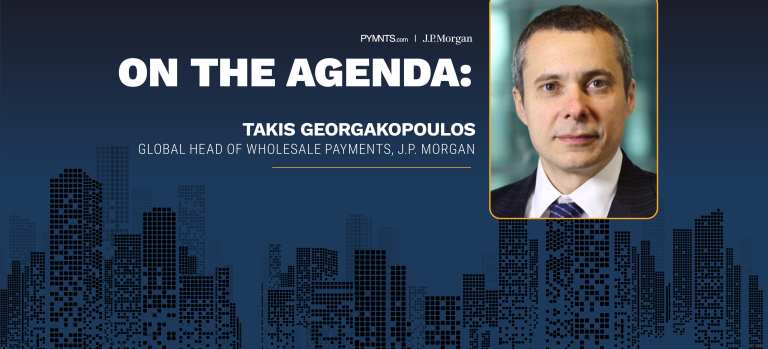
The impact of the global pandemic on corporates’ digitization journeys has been undeniable. Whether businesses were establishing their modernization roadmaps for the first time or simply accelerating the plans they already had in place, the COVID-19 crisis drove organizations to embrace technology at unprecedented levels in order to manage a remote workforce, supply chain disruptions and economic uncertainty.
Spearheading many of those efforts was the corporate treasurer. Once considered the head of number-crunching and cash management, treasurers today have transformed into enterprise leaders, using payments and finance digitization as an opportunity to pivot toward new business models and drive strategic growth for the entire enterprise.
According to Takis Georgakopoulos, global head of wholesale payments at J.P. Morgan, treasurers will be taking key lessons learned from 2020 into the new year as they continue along their modernization path. In a conversation with PYMNTS’ Karen Webster, Georgakopoulos reflected on how treasurers have navigated the disruption and also discussed J.P. Morgan’s strategies to support treasurers’ efforts through its own digitization roadmap.
Treasurers As Strategic Leaders
While the trend of corporate treasurers seeking ways to enhance the global visibility of bank accounts and payment flows was clearly there well before the pandemic, said Georgakopoulos, what changed was a sense of urgency from clients to move to a digital environment with a renewed focus on guiding their organizations through the volatility.
“This is not just about treasury departments trying to make money movements more efficient,” he said. “It’s about digitizing how the whole business operates.”
Digitization was no longer simply a benefit, but a necessity — and according to Georgakopoulos, treasurers had an important seat at the leaders’ table to guide the enterprise toward greater agility, expansion into new markets and customer segments, and an overall optimized financial strategy.
Of course, the digital transformation leaders this year were the organizations that prioritized technology from the onset. Driving this modernization focus was the need for organizations to optimize the way they interacted with customers, business partners and banks through tools like digital onboarding, electronic signatures, real-time connectivity and real-time reporting and data-driven insights. Georgakopoulos pointed to digital marketplaces and eCommerce firms, which emerged as leaders in this regard thanks to their investments in cloud-first infrastructure and application programming interfaces (APIs), tools that enabled treasury systems to more seamlessly operate and interact with each other.
Treasurers also quickly became leaders for their firms, exploring how to adjust business models in response to dramatic changes in the market. B2C companies that had once relied on intermediaries to sell goods embraced the direct-to-consumer model, while B2B firms focused on transforming their own interactions with corporate clients. And with those changes came a need to adjust financial strategies, with treasury departments embracing the opportunity to wield real-time data and optimizing account structures to support a more efficient way to operate the entire business.
Elevating The Bank/Treasurer Relationship
Georgakopoulos said J.P. Morgan understood the role that financial institutions (FIs) play in supporting their treasurer clients’ modernization goals. To do so effectively, he said, banks must embrace their own digitization roadmaps.
At the onset of the pandemic, J.P. Morgan’s key focuses were migrating about 80 percent of its workforce to safely work from home, continuing to process about $7 trillion in transactions every day without disruption and collaborating with corporate clients on their business model transformation initiatives. Digitization strategies that were set forth well before the pandemic quickly proved instrumental in achieving those goals.
“Probably the biggest decision we made several years ago was to invest heavily in technology and modernizing our platform, because at the end of the day, if your technology is not agile, and if your APIs or onboarding don’t work well, there is very little innovation that you can do,” said Georgakopoulos.
Those investments have paid off, with Georgakopoulos pointing to the bank’s investments in its virtual assistant technology, digital signatures and a full suite of payments APIs, which saw rapid adoption from corporate clients when the pandemic hit.
But these upgrades weren’t just important for helping treasurers navigate the pandemic. They will also continue to be vital to aiding corporates as their goals for the long term evolve. For J.P. Morgan, payments modernization is a key focus.
Georgakopoulos highlighted the eCommerce and healthcare customer segments as particularly exciting areas that are ripe for transformation. J.P. Morgan is also focusing on growing small business payment services and innovation — including its proprietary JPM Coin and its newly branded blockchain unit, Onyx by J.P. Morgan.
As J.P. Morgan makes strides in its own digital transformation journey, collaboration with FinTechs will be valuable in developing products and services to better address treasurers’ shifting needs, too. In addition to partnerships and acquisitions, Georgakopoulos said the FinTech ecosystem presents the opportunity to raise the bar for the financial services landscape as a whole.
“We are learning from FinTechs and we are excited at what’s ahead in 2021.”